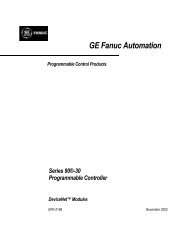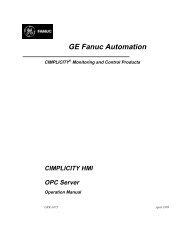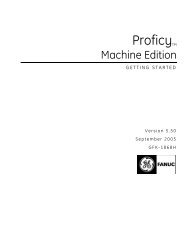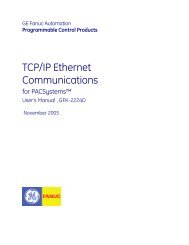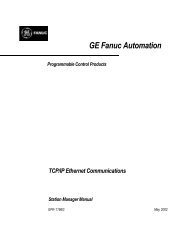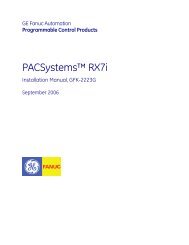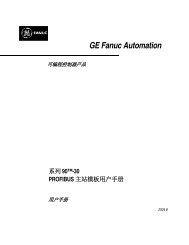Series 90-70 Genius Bus Controller Manual, GFK-2017
Series 90-70 Genius Bus Controller Manual, GFK-2017
Series 90-70 Genius Bus Controller Manual, GFK-2017
- No tags were found...
Create successful ePaper yourself
Turn your PDF publications into a flip-book with our unique Google optimized e-Paper software.
1The <strong>Genius</strong> <strong>Bus</strong>The <strong>Genius</strong> bus is a shielded twisted-pair wire, daisy-chained between devices, andterminated at both ends. Proper cable selection is critical to successful operation ofthe system. Suitable cable types are listed in the <strong>Genius</strong> I/O System User’s <strong>Manual</strong>.Conservative wiring practices, as well as national and local codes, require physicalseparation between control circuits and power distribution or motor power. Refer tosections 430 and 725 of the National Electric Code.<strong>Bus</strong> Type<strong>Bus</strong>TerminationDaisy-chained bus cable; single twisted pair plus shield or Twinax.Fiber optics cable and modems can also be used.75, 100, 120, or 150 ohm resistor at both ends of electrical buscable.Baud Rate Configurable. 153.6 Kbaud standard, 153.6 Kbaud extended, 76.8Kbaud, or 38.4 Kbaud.Maximum <strong>Bus</strong>Length7500 feet at 38.4 Kbaud, 4500 feet at 76.8 Kbaud, 3500 feet at153.6 Kbaud extended, 2000 feet at 153.6 Kbaud, standard.Maximum length at each baud rate also depends on cable type.Chapter 2 provides a complete list of cable types, showingcorresponding bus lengths and baud rates.Greater bus lengths are possible using sections of fiber optics cablewith modems.MaximumNumber ofDevicesData EncodingModulationTechniqueIsolationSignal/noiseRatio32 devices at 153.6 Kbaud standard, 153.6 Kbaud extended, or 76.8Kbaud. 16 devices at 38.4 Kbaud. Includes bus controller andtypically a Hand-held Monitor.Each bit is encoded into three dipulses, majority voted at thereceiver to correct any single dipulse errors. A dipulse is an ACcode consisting of a positive then negative excursion of voltage.Dipulses are individually sampled to reject low and high frequencyinterference.Frequency Shift Keying (FSK) 0 to 460.8 KHz max. (153.6 Kilobaud)2000 volts Hi-Pot, 1500 volts transient common mode rejection.60 db<strong>GFK</strong>-<strong>2017</strong> Chapter 1 Introduction 1-5




